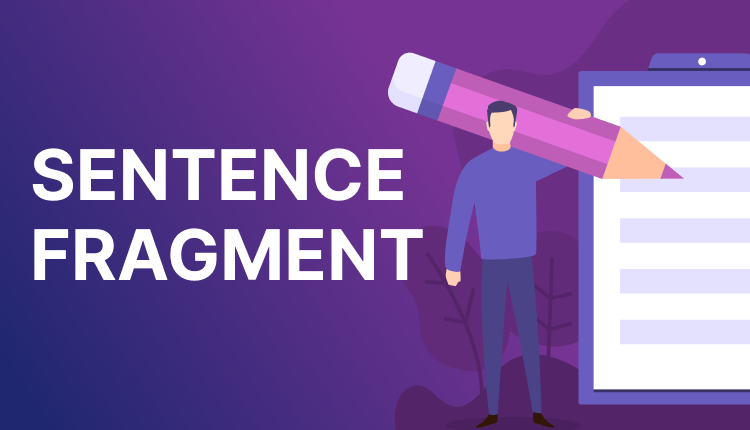Ever come across a sentence that just hangs there, dangling in the air, leaving you perplexed? It’s a world of sentence fragments-the sneaky little grammar issue that can creep into our writing unnoticed.
Either you’re writing an essay, drafting an e-mail message, or even just jotting down some ideas on paper, knowing what a sentence fragment is will help you get your point across. Let’s move into this really interesting part of language to see how to identify and fix those pesky fragments of yours!
What Is a Sentence Fragment?
A sentence fragment is a group of words that does not express a complete thought. It usually has either missing subject, verb, or both. For this reason, it deprives the reader of completing information.
For example, take the sentence “Running through the park.” Of course, it will create a picture in your head, but it does not tell who’s running or what’s going to happen next.
Another very common fragment would be “Although she was tired.” It opens up options, but finishes the sentence for the reader nowhere, so they hang in mid-sentence with nothing presented in context.
In real life writing, fragments may happen a lot and the first time you don’t catch on. Getting familiar with them can really make a difference in how clear your writing is.
Frequently Encountered Fragments
Some sentence fragments may go without ever being notice. Sometimes they only leave us with incomplete ideas and break up our thoughts.
The first common kind is a dependent clause standing alone. For example: “Although I was tired.” It leaves the reader hanging for more information.
Another common fragment is where you are left with a subject or a verb, as in this fragment: “Running down the street.” It has vivid imagery but leaves it hanging with no context.
Many sentence fragments come from missing main clauses. A good example of this would be: “When we arrived at the party.” It implies that something happened, but it doesn’t say what.
They enter speech just as insidiously, so they can be pitfalls for writers of any skill level. Awareness of these patterns can also make your writing clearer and more coherent.
How to Fix Sentence Fragments?
Sentence fragments must be completed for clarity. Identify the fragment. Look for any partially expressed thoughts or for phrases lacking either a subject or a verb.
When you identify a fragment look for a way to combine it with a complete sentence. This will add important context and continuity
Another approach is to add what is missing. If your fragment is missing a subject, attach that small piece of missing information to the front of it.
You can also make fragments full sentences by adding suitable verbs or conjunctions. It gives your writing such depth and clarity.
You can often spot problems of this kind if you read out loud. Sometimes you will get the rhythm of your words and sense where awkward breaks need fixing.
Drafting constantly gives you time to catch lingering fragments before finalizing any piece of your writing. Come to enjoy this part of the editing process-it will really improve your writing’s overall readability.
Examples of Sentence fragment
Sentence fragments come in a multitude of forms, but these examples ought to explain this grammatical hiccup.
Consider this phrase: “Although she loves music.” It sounds incomplete because it leaves you hanging, craving more information about what happens next.
Common examples abound. Take “Running through the park.” This feels very much like a thought that needs a subject and verb to be complete.
Consider “When we finally arrived.” Again, you are left wondering what comes after this introduction.
Even the most ordinary phrases, like “The best pizza ever“, fail to include some critical elements which make it unclear.
Awareness of these fragments results in tremendous enhancement in writing. Your awareness of them allows you to create stronger and clearer sentences that you can use in order to communicate complete thoughts.
How Trinka Grammar checker can help you to fix sentence fragments
Knowing sentence fragmentation and how to correct it will ensure continued effective communication. Trinka Grammar Checker can lead you through the process. The software is tailored to scan your writing, identifying places where sentences have been omitted or disrupt the flow.
With the easy interface of Trinka, you identify potential sentence fragments, noting possible corrections. Real-time information is sent regarding restating those fragments into complete sentences.
Secondly, the application gives you explanations that help you learn common mistakes as you edit the work. That is, it enhances your current writing, but also prevents you from making such mistakes again later on.
Trinka will be using the skills and equipment to properly refine your writing style and clarity of thought in all your writing. Be it an essay creation or the editing of a blog post, it doubles as guide and editor-cum-helper tool on how to resolve problematic sentence fragments.
Frequently Asked Questions on Sentence Fragments
Can a fragment ever be used effectively in writing?▼
The answer is yes. And, as you know by now, writers continually use them for emphasis and even stylistic purposes.
How to recognize a sentence fragment?▼
In general, you look for phrases that do not contain either a subject or a verb. If it doesn’t convey a complete thought, you’ve spotted yourself a fragment.
Are fragments ever acceptable in any form of writing?▼
In informal settings – in texting or on social media – to use two of the most obvious examples, they’re not only accepted, but are frequently used to add a dash of brevity and punch.
How to distinguish between sentence fragments and run-on sentences?▼
In sentence fragments, the sentences do not fully express an idea, whereas in run-on sentence, two independent clauses are joined without a punctuation. Knowing all these subtleties helps clarity even on when and how one should be making proper use of sentence fragments in his or her writing journey.

